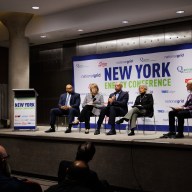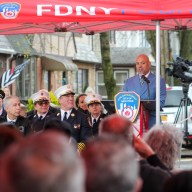By Bill Parry
The massive Astoria Cove project finally got the green light Tuesday when the full City Council voted unanimously in favor of the plan. The vote was perfunctory, having passed through the Land Use subcommittee last week.
City Councilman Costa Constantinides (D-Astoria) pushed for additional affordable housing units during the final phase of the six-month approval process. After negotiations with 2030 Astoria Developers stretched into the final minute, the builders agreed to make 27 percent of the residential floor area of the building available to varying income levels.
“Residential development in the 21st century must be innovative, contextual and inclusive of its community,” Constantinides said outside City Hall. “I am proud to have reached this goal by passing this historic agreement at Astoria Cove.”
The project proposes to transform an isolated and underutilized area of the Hallets Point peninsula. “This transformational project will be one of the most environmentally friendly and sustainable in the city’s history,” 2030 Astoria Developers Managing Partner John Mavroudis said. “It will result in a public waterfront esplanade with two-acres of parkland, a 456-seat elementary school, 110,000-square-feet of street-level retail, and so much more. Astoria Cove will bring overdue and significant investment to transform the future of the immediate community and enable connections to the rest of Astoria.”
The deal was seen as a coup for the de Blasio administration because it was a test case for his new mandatory inclusionary zoning policy, which requires developers to include affordable units as a precondition for construction.
“For the first time in city history, the developer will be required by law to provide permanently affordable housing that is within reach of Astorians,” Constantinides said. “In one of the largest agreements on affordable housing in city history, a record 27 percent of the development will be permanently reserved for low- and middle-income households. The development will also use a fully unionized work force, bringing good jobs in an area that needs them.”
Jay Valgora, the architect who designed Astoria Cove as well as the nearby Hallets Point project that was approved by the City Council last year, said, “It’s the right project for the community and it achieves everyone’s goals. Right now it’s nothing but dirt roads with trailers on it and fences keeping the public away from the waterfront. We want to break down the walls and reconnect the community with their waterfront.”
Astoria Houses Resident Association President Claudia Conger and Vice President Renee Edwards are supporters of the project.
“The Astoria Houses are in arguably one of the most segregated pockets of poverty in Queens, and it’s been that way for decades,” they said in a joint statement. “Now the Astoria Cove development offers a chance to help change that for the better. This project will bring hundreds of construction and permanent jobs to the neighborhood for residents to take advantage of.”
Transportation issues in Astoria led Community Board 1 and Queens Borough President Melinda Katz to not endorse the plan during the early stages of the approval process. The mayor’s office agreed to commit $5 million toward the construction of a ferry dock to help make the deal happen.
“This agreement shows what we can achieve when the private and public sectors work together,” Constantinides said. “This agreement provides real benefits to the neighborhood and will also help further link our booming communities along the East River.”
Reach reporter Bill Parry by e-mail at bparry@cnglocal.com or by phone at (718) 260–4538.





























